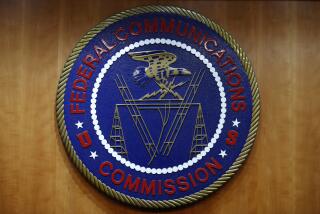FCC Releases Its Plan for Phasing In Television V-Chip
- Share via
WASHINGTON — U.S. regulators unveiled a plan Thursday for technical standards for television manufacturers to begin phasing in the so-called V-chip that will help parents block programs they don’t want their children to see.
The Federal Communications Commission rule, which is now up for public comment, “will ensure that V-chip technology does in fact exist in a relatively short period of time,” Chairman Reed Hundt said.
Under the proposed rule, the chip would be installed by July 1, 1999, in all TV sets with monitors 13 inches or larger, the FCC said. Television set makers, such as Zenith Electronics Corp., Sony Corp. and RCA/Thomson Consumer Electronics, have until July 1, 1998, to put the chip in half of their sets, and until 1999 to have them in all their sets.
The chip would let parents push a button either on the remote control or on the set that would display a menu screen that would let parents choose which rated programs they want blocked.
Industry officials said the time frame for manufacturing the new televisions is too short. “The timeline is just not doable for the manufacturers,” said Ed Korenman, a spokesman for the Electronic Industry Assn. The industry group advised the FCC during its consideration of the rule.
Companies “have been holding off on chip production until the rules are set,” Korenman said. “Asking them to have a system designed and in place by July is a lot to ask.”
The chip was included in last year’s telecommunications measure, in conjunction with a new content-based TV ratings system that takes effect Oct. 1.
The new system couples age-appropriate categories with content labels: S, for sex; V, for violence; L, for foul language; and D, for suggestive dialogue. It also includes FV, a fantasy violence label for children’s shows. The chip would be able to identify programs by rating and block them accordingly.
The commission has not yet ruled on the propriety of the actual ratings system, Hundt said. “We wanted to get in the process of adopting the rules that would ensure the receivers had blocking technology.”
Still, the FCC rule is far from complete, said FCC Commissioner Susan Ness.
“This item is necessary, but not sufficient,” Ness said, noting that the rule does not address how to make the chip without increasing the price of television sets exponentially.
The rule will not go into effect until November, after the industry has the opportunity to comment on it and the commission to respond.






